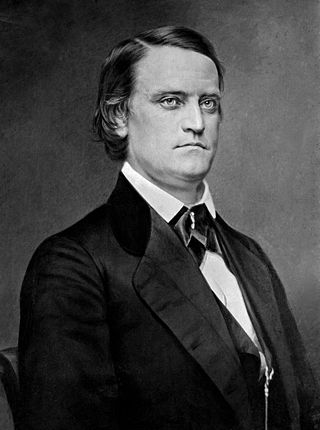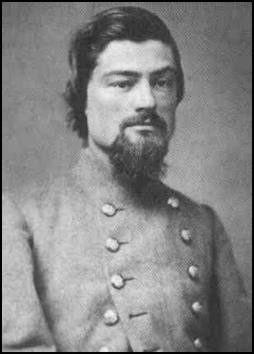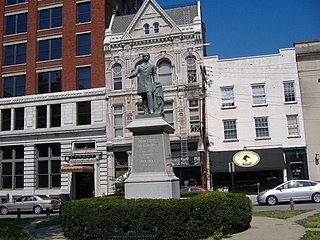
John Cabell Breckinridge was an American lawyer, politician, and soldier. He represented Kentucky in both houses of Congress and became the 14th and youngest-ever Vice President of the United States. Serving from 1857 to 1861, he took office at the age of 36. He was a member of the Democratic Party, and ran for president in 1860 as a Southern Democrat. He served in the U.S. Senate during the outbreak of the American Civil War, but was expelled after joining the Confederate Army. He was appointed Confederate Secretary of War in 1865.

John Hunt Morgan was a Confederate general in the American Civil War. In April 1862, he raised the 2nd Kentucky Cavalry Regiment, fought at Shiloh, and then launched a costly raid in Kentucky, which encouraged Braxton Bragg's invasion of that state. He also attacked the supply-lines of General William Rosecrans. In July 1863, he set out on a 1,000-mile raid into Indiana and Ohio, taking hundreds of prisoners. But after most of his men had been intercepted by Union gunboats, Morgan surrendered at Salineville, Ohio, the northernmost point ever reached by uniformed Confederates. The legendary "Morgan's Raid", which had been carried out against orders, gained no tactical advantage for the Confederacy, while the loss of his regiment proved a serious setback. Morgan escaped from Union prison but his credibility was low, and he was restricted to minor operations. He was killed at Greeneville, Tennessee, in September 1864. Morgan was the brother-in-law of Confederate general A. P. Hill. Various schools and a memorial are dedicated to him.

Lexington Cemetery is a private, non-profit 170-acre (69 ha) rural cemetery and arboretum located at 833 W. Main Street, Lexington, Kentucky.

Basil Wilson Duke was a lawyer in Kentucky and a Confederate general officer during the American Civil War. Afterward he achieved renown as a historian. His most noted service in the war was as second-in-command to his brother-in-law John Hunt Morgan. Duke later wrote a popular account of what was called Morgan's Raid (1863). He took over Morgan's command in 1864 after Morgan was fatally shot by Union soldiers. At the end of the war, Duke served among Confederate President Jefferson Davis's bodyguards after his flight from Richmond, Virginia, through the Carolinas.

Henry Cornelius Burnett was an American politician who served as a Confederate States senator from Kentucky from 1862 to 1865. From 1855 to 1861, Burnett served four terms in the United States House of Representatives. A lawyer by profession, Burnett had held only one public office—circuit court clerk—before being elected to Congress. He represented Kentucky's 1st congressional district immediately prior to the Civil War. This district contained the entire Jackson Purchase region of the state, which was more sympathetic to the Confederate cause than any other area of Kentucky. Burnett promised the voters of his district that he would have President Abraham Lincoln arraigned for treason. Unionist newspaper editor George D. Prentice described Burnett as "a big, burly, loud-mouthed fellow who is forever raising points of order and objections, to embarrass the Republicans in the House".
The Orphan Brigade was the nickname of the First Kentucky Brigade, a group of military units recruited from Kentucky to fight for the Confederate States of America during the American Civil War. The brigade was the largest Confederate unit to be recruited from Kentucky during the war. Its original commander was John C. Breckinridge, former United States vice president, and Kentucky's former senator, who was enormously popular with Kentuckians.

Richard Hawes Jr. was a United States representative from Kentucky and the second Confederate Governor of Kentucky. He was part of the politically influential Hawes family. His brother, uncle, and cousin also served as U.S. Representatives, and his grandson Harry B. Hawes was a member of the United States Senate. He was a slaveholder.

Thomas Elliott Bramlette was the 23rd Governor of Kentucky. He was elected in 1863 and guided the state through the latter part of the Civil War and the beginning of Reconstruction. At the outbreak of the war, Bramlette put his promising political career on hold and enlisted in the Union Army, raising and commanding the 3rd Kentucky Infantry. In 1862, President Abraham Lincoln appointed him district attorney for Kentucky. A year later, he was the Union Democrats' nominee for governor. Election interference by the Union Army gave him a landslide victory over his opponent, Charles A. Wickliffe. Within a year, however, federal policies such as recruiting Kentucky African-Americans for the Union Army and suspending the writ of habeas corpus for Kentucky citizens caused Bramlette to abandon his support of the Lincoln administration and declare that he would "bloodily baptize the state into the Confederacy".

George Washington Johnson was the first Confederate governor of Kentucky. A lawyer-turned-farmer from Scott County, Kentucky, Johnson, a supporter of slavery who owned 26 slaves, favored secession as a means of preventing the Civil War, believing the Union and Confederacy would be forces of equal strength, each too wary to attack the other. As political sentiment in the Commonwealth took a decidedly Union turn following the elections of 1861, Johnson was instrumental in organizing a sovereignty convention in Russellville, Kentucky, with the intent of "severing forever our connection with the Federal Government." The convention created a Confederate shadow government for the Commonwealth, and Johnson was elected its governor. This government never controlled the entire state though it controlled about half the state early in the war, Kentucky remained in the Union after 1862 throughout the rest of the war.

Kentucky was a southern border state of key importance in the American Civil War. It officially declared its neutrality at the beginning of the war, but after a failed attempt by Confederate General Leonidas Polk to take the state of Kentucky for the Confederacy, the legislature petitioned the Union Army for assistance. Though the Confederacy controlled more than half of Kentucky early in the war, after early 1862 Kentucky came largely under Union control. In the historiography of the Civil War, Kentucky is treated primarily as a southern border state, with special attention to the social divisions during the secession crisis, invasions and raids, internal violence, sporadic guerrilla warfare, federal-state relations, the ending of slavery, and the return of Confederate veterans.

Louisville in the American Civil War was a major stronghold of Union forces, which kept Kentucky firmly in the Union. It was the center of planning, supplies, recruiting and transportation for numerous campaigns, especially in the Western Theater. By the end of the war, Louisville had not been attacked once, although skirmishes and battles, including the battles of Perryville and Corydon, Indiana, took place nearby.

The Confederate government of Kentucky was a shadow government established for the Commonwealth of Kentucky by a self-constituted group of Confederate sympathizers and delegates sent by Kentucky counties, during the American Civil War. The shadow government never replaced the elected government in Frankfort, in which the state legislature had strong Union sympathies while the governor was pro-Confederate. Neither was it able to gain the whole support of Kentucky's citizens; its jurisdiction extended only as far as Confederate battle lines in the Commonwealth, which at its greatest extent in 1861 and early 1862 encompassed over half the state. Nevertheless, the provisional government was recognized by the Confederate States of America, and Kentucky was admitted to the Confederacy on December 10, 1861. Kentucky, the final state admitted to the Confederacy, was represented by the 13th (central) star on the Confederate battle flag.

The John Hunt Morgan Memorial in Lexington, Kentucky, is a monument created during the Jim Crow era, as a tribute to Confederate General John Hunt Morgan, who was from Lexington and is buried in Lexington Cemetery. The monument was originally situated on the Courthouse Lawn at the junction of North Upper and East Main Street, but was moved to Lexington Cemetery in 2018.

The John C. Breckinridge Memorial, originally on the courthouse lawn of Lexington, Kentucky, was placed on the National Register of Historic Places on July 17, 1997, as part of the Civil War Monuments of Kentucky MPS. It commemorates John C. Breckinridge, who was born and died in Lexington. He was Vice President for James Buchanan and ran against Abraham Lincoln in the 1860 United States presidential election, winning nine Southern states. He served in the Confederate States Army, and was the last Confederate States Secretary of War, fleeing the country after the South lost.

The Ladies' Confederate Memorial is an American Civil War monument erected in 1874 in Lexington Cemetery in Lexington, Kentucky. It was placed on the National Register of Historic Places on July 17, 1997, as part of the Civil War Monuments of Kentucky MPS. Unlike most Confederate monuments in Kentucky, it represents grief rather than Southern patriotism.

The Confederate Monument in Cynthiana is located on the outer edge of Cynthiana, Kentucky in Battle Grove Cemetery. It was the first monument to the Confederate States of America dedicated in the State of Kentucky, and long believed to be the first Confederate memorial anywhere. Due to the 32nd Indiana Monument having been moved from its original location, the Cynthiana monument is the oldest Civil War monument still standing at its original location, where the second Battle of Cynthiana started, in the then-new town cemetery.

The Confederate Monument in Danville, originally located between Centre College and the First Presbyterian Church at the corner of Main and College Streets in Danville, Kentucky, was a monument dedicated to the Confederate States of America that is on the National Register of Historic Places. The monument was dedicated in 1910 by the surviving veterans of the Confederacy of Boyle County, Kentucky and the Kate Morrison Breckinridge Chapter of the United Daughters of the Confederacy (UDC). In 2021, it was relocated to a museum in Meade County, Kentucky.

Benjamin Hardin Helm was an American politician, attorney, and Confederate brigadier general. A son of Kentucky governor John L. Helm, he was born in Bardstown, Kentucky. He attended the Kentucky Military Institute and the West Point Military Academy and then studied law at the University of Louisville and Harvard University. He served as a state legislator and the state's attorney in Kentucky. Helm was offered the position of Union Army paymaster by his brother-in-law, President Abraham Lincoln, a position which he declined. Helm joined the Confederate States Army. As a brigadier general, Helm commanded the 1st Kentucky Brigade, more commonly known as The Orphan Brigade. He died on the battlefield during the Battle of Chickamauga.
The Mississippi was an important military highway that bordered ten states, roughly equally divided between Union and Confederate loyalties.
The Breckinridge family exerted a powerful influence in the divided slave-state of Kentucky, with Breckinridge County dating back well before its current constitution of 1799. They were viewed as southern aristocracy, counting many Confederate generals among their cousins. But family members also fought in the Union army, and supported Lincoln throughout the conflict.
























